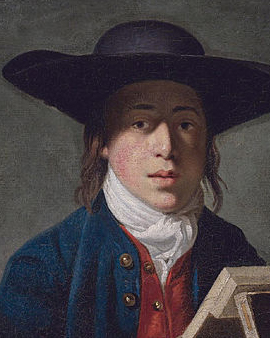George Morland was the son of portraitist Henry Robert Morland and the grandson of genre painter George Henry Morland. His education began at a very young age. Morland painted already at the age of 3 years. He was allowed to exhibit his first drawings at the Royal Academy at the age of 10. His father Henry Robert is said to have been very strict and forbade the boy everything that could have somehow hindered his creative development. When he was not on long drawing excursions or painting at home, he was only allowed to read or practice the violin. The father's strict upbringing was not supposed to have been altruistic. Morland had to make countless copies of various painters for his father. He stayed with his father until 1784. Then he obviously had enough of being patronized, because Morland broke with his father and moved in with an art dealer. But even here the desired independence failed to materialize, for his patron exploited him at least as much as his father. About a year later, Morland was finally able to free himself from the awkward situation. He moved to another city to work as a portraitist.
After a short stay in France Morland returned to London. There he lived near his friend and colleague William Ward. The closeness to Ward and his family brought stability to Morland's life, which his difficult childhood had driven to alcohol and other debauchery. He married Ward's sister Anne. One month later Ward married Morland's sister Maria. The two couples lived together in a house after the wedding. But after only 3 months there were already disputes between the two women, so that the common household had to be dissolved. For some years the married life could prevent Morland's escapades. The nights he spent in pubs and in dubious company seemed to belong to the past. But the long illness of his wife after the stillbirth of their first and only child threw Morland off course again. He began to drink, which put an increasing strain on the marriage. The couple finally separated.
At first, however, the alcohol addiction seemed to have little effect on his work. Morland is said to have done 1 or 2 paintings a day. In the course of his career he created more than 4000 works. But at some point the income was no longer sufficient to finance his decadent lifestyle and he became a hunted man with creditors breathing down his neck. He hid out with various friends and in taverns until he was finally arrested in 1799. Morland was initially able to negotiate a kind of open prison sentence. But this did not improve his situation, because he drank as much as he worked. In the end he was hardly able to keep his colour palette due to paralysis. When he ran up debts again, he was sent to prison, where he died at the age of 41.
×





.jpg)
.jpg)
.jpg)
.jpg)
.jpg)
.jpg)
.jpg)
.jpg)
_-_(MeisterDrucke-904861).jpg)
_-_(MeisterDrucke-904861).jpg)
.jpg)
.jpg)
.jpg)
.jpg)
.jpg)
.jpg)
.jpg)
.jpg)
.jpg)
.jpg)
.jpg)
.jpg)
.jpg)
.jpg)
.jpg)
.jpg)
.jpg)
.jpg)
.jpg)
.jpg)
_-_(MeisterDrucke-1363155).jpg)
_-_(MeisterDrucke-1363155).jpg)
.jpg)
.jpg)
.jpg)
.jpg)
.jpg)
.jpg)
.jpg)
.jpg)
.jpg)
.jpg)
 - (MeisterDrucke-177187).jpg)
 - (MeisterDrucke-177187).jpg)
 1789 - (MeisterDrucke-88920).jpg)
 1789 - (MeisterDrucke-88920).jpg)
_-_(MeisterDrucke-1369562).jpg)
_-_(MeisterDrucke-1369562).jpg)
.jpg)
.jpg)
.jpg)
.jpg)
.jpg)
.jpg)
.jpg)
.jpg)
.jpg)
.jpg)
_and_watercolour_on_paper_(pasted_on_paper))_-_(MeisterDrucke-210195).jpg)
_and_watercolour_on_paper_(pasted_on_paper))_-_(MeisterDrucke-210195).jpg)
_1793_(oil_on_canvas)_-_(MeisterDrucke-1466384).jpg)
_1793_(oil_on_canvas)_-_(MeisterDrucke-1466384).jpg)
 pub by James Linnell 1806 (mezzotint engraving) - (MeisterDrucke-191198).jpg)
 pub by James Linnell 1806 (mezzotint engraving) - (MeisterDrucke-191198).jpg)
_-_(MeisterDrucke-1120580).jpg)
_-_(MeisterDrucke-1120580).jpg)
.jpg)
.jpg)
.jpg)
.jpg)
 pub by T - (MeisterDrucke-252177).jpg)
 pub by T - (MeisterDrucke-252177).jpg)
.jpg)
.jpg)
.jpg)
.jpg)
.jpg)
.jpg)
_-_(MeisterDrucke-1359971).jpg)
_-_(MeisterDrucke-1359971).jpg)
.jpg)
.jpg)
.jpg)
.jpg)
_-_(MeisterDrucke-1362564).jpg)
_-_(MeisterDrucke-1362564).jpg)
.jpg)
.jpg)
.jpg)
.jpg)
_pub_by_H_Morland_1806_(mezzot_-_(MeisterDrucke-188434).jpg)
_pub_by_H_Morland_1806_(mezzot_-_(MeisterDrucke-188434).jpg)
.jpg)
.jpg)
.jpg)
.jpg)
.jpg)
.jpg)
_-_(MeisterDrucke-86370).jpg)
_-_(MeisterDrucke-86370).jpg)
_-_(MeisterDrucke-95213).jpg)
_-_(MeisterDrucke-95213).jpg)
.jpg)
.jpg)
.jpg)
.jpg)
.jpg)
.jpg)
.jpg)
.jpg)
.jpg)
.jpg)
.jpg)
.jpg)
.jpg)
.jpg)
.jpg)
.jpg)
.jpg)
.jpg)
_-_(MeisterDrucke-1641295).jpg)
_-_(MeisterDrucke-1641295).jpg)
.jpg)
.jpg)
.jpg)
.jpg)
.jpg)
.jpg)
.jpg)
.jpg)
.jpg)
.jpg)
.jpg)
.jpg)
.jpg)
.jpg)
 - (MeisterDrucke-272640).jpg)
 - (MeisterDrucke-272640).jpg)
_-_(MeisterDrucke-322455).jpg)
_-_(MeisterDrucke-322455).jpg)
.jpg)
.jpg)
.jpg)
.jpg)
.jpg)
.jpg)
.jpg)
.jpg)
.jpg)
.jpg)
_-_(MeisterDrucke-1315213).jpg)
_-_(MeisterDrucke-1315213).jpg)
.jpg)
.jpg)
 - (MeisterDrucke-92919).jpg)
 - (MeisterDrucke-92919).jpg)
.jpg)
.jpg)
 - (MeisterDrucke-635547).jpg)
 - (MeisterDrucke-635547).jpg)
.jpg)
.jpg)
.jpg)
.jpg)
_-_(MeisterDrucke-321958).jpg)
_-_(MeisterDrucke-321958).jpg)
.jpg)
.jpg)
.jpg)
.jpg)
.jpg)
.jpg)
.jpg)
.jpg)
.jpg)
.jpg)
.jpg)
.jpg)
.jpg)
.jpg)
.jpg)
.jpg)
_-_(MeisterDrucke-390946).jpg)
_-_(MeisterDrucke-390946).jpg)
.jpg)
.jpg)
.jpg)
.jpg)
.jpg)
.jpg)
.jpg)
.jpg)
.jpg)
.jpg)
_-_(MeisterDrucke-1120581).jpg)
_-_(MeisterDrucke-1120581).jpg)
_-_(MeisterDrucke-899886).jpg)
_-_(MeisterDrucke-899886).jpg)
.jpg)
.jpg)




